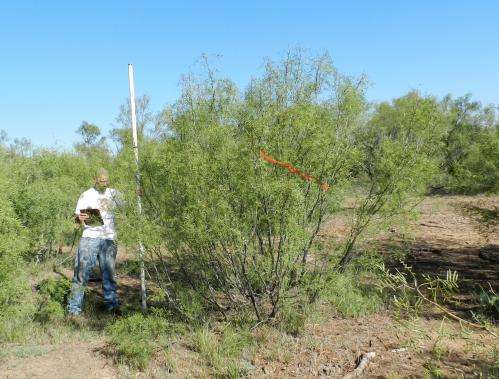Mesquite a complementary biofuel feedstock

As requirements grow for use of cellulosic biofuels to meet the energy needs of the nation, researchers look at potential feedstocks and any effects these alternative sources may have on greenhouse gas emissions.
A recent Texas A&M AgriLife Research study will be published in the BioEnergy Research journal, outlining how mesquite, growing in abundance in some regions of the southwest, could fit into the overall picture.
The paper is based on the study "Economic and Greenhouse Gas Efficiency of Honey Mesquite Relative to Other Energy Feedstocks for Bioenergy Uses in the Southern Great Plains."
The AgriLife Research team conducting the study included Dr. Seong Park, economist; Dr. Tong Wang, a post-doctoral researcher; and Dr. Jim Ansley, rangeland ecologist, all in Vernon. They were joined by Dr. Steve Amosson, Texas A&M AgriLife Extension Service economist in Amarillo.
Bioenergy feedstocks have been promoted globally as potential means to offset greenhouse gas emissions by replacing fossil fuels such as gas and coal, Park said. In the U.S., federal support has played a key role in the biofuel industry. Examples include the Renewable Fuel Standard, established with the Energy Policy Act of 2005, and later expanded.
The Energy Independence and Security Act of 2007 stipulates the annual use of at least 16 billion gallons of cellulosic biofuels and a cap of 15 billion gallons of corn starch ethanol by 2022, Park said. In addition, biofuels are being examined from the standpoint of lifecycle greenhouse gas emission reductions.
Despite the initial promise of grain-based biofuels, such as corn, there have been a number of concerns that grain-based biofuel may generate even higher greenhouse gas emissions than fossil fuels, he said. Planting grain-based species could also accelerate the depletion of the Ogallala Aquifer or other scarce water resources.
The AgriLife Research study evaluated the economic and greenhouse gas efficiencies of honey mesquite compared to irrigated and dryland sweet sorghum and dryland switchgrass, Park said.
Despite its higher energy density per pound, mesquite production values on a per-land area basis are lower than other feedstocks observed in this comparison and therefore could not replace them entirely, he said. But, mesquite appears to be suitable as a complementary feedstock to contribute tototal biomass demand.
"Our results suggest that mesquite lagged slightly behind switchgrass when the biomass and energy efficiency were considered," Wang said. "However, mesquite appeared superior to all the feedstocks in two categories – greenhouse gas offset efficiency and greenhouse gas use efficiency once land-use change effects were accounted for."
She said the study results are "pretty robust as they still hold true in the worst scenario proposed for mesquite."
Park said mesquite has even greater potential if additional benefits such as increased grass production for livestock grazing and reduction in herbicide or mechanical removal costs for mesquite control are considered.
"The biggest negative is lower biomass production per acre per year for mesquite compared to other feedstocks," he said.
However, features such as no fertilizer, irrigation or weed control costs; the unlimited re-harvest potential every 10-12 years; the ability to harvest year round; and a dry moisture content all help costs and improve carbon efficiencies.
Additional studies are needed to put mesquite's potential into perspective, Park said. Future research areas could focus on developing a landscape scale, GIS-based decision support system to determine optimum feedstock harvesting and processing logistics on rangelands.
Other potential studies heoutlined could determine the rate of ecosystem restoration, hydrological impact, and ecological and economic sustainability of woody harvest, as well as compare these fuels on regional water use and water use efficiencies.
More information: "Economic and Greenhouse Gas Efficiency of Honey Mesquite Relative to Other Energy Feedstocks for Bioenergy Uses in the Southern Great Plains." Tong Wang, Seong Park, R. James Ansley, Stephen H. Amosson. BioEnergy Research. June 2014. Date: 03 Jun 2014. DOI: 10.1007/s12155-014-9475-z
Journal information: Bioenergy Research
Provided by Texas A&M University

















